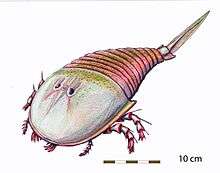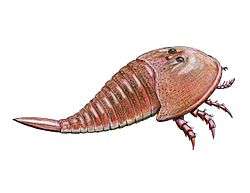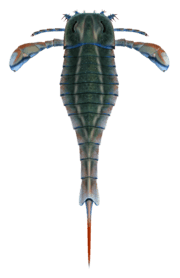Hibbertopteridae
| Hibbertopteridae | |
|---|---|
 | |
| Reconstruction of Campylocephalus. | |
| Scientific classification | |
| Kingdom: | Animalia |
| Phylum: | Arthropoda |
| Subphylum: | Chelicerata |
| Order: | †Eurypterida |
| Suborder: | †Stylonurina |
| Superfamily: | †Mycteropoidea |
| Family: | †Hibbertopteridae Kjellesvig-Waering, 1959 |
| Type genus | |
| Hibbertopterus Kjellesvig-Waering, 1959 | |
| Genera | |
| Synonyms | |
| |
The Hibbertopteridae are a family of eurypterids, an extinct group of chelicerate arthropods commonly known as "sea scorpions". The family is one of three families contained in the superfamily Mycteropoidea (along with Mycteroptidae and Drepanopteridae), which in turn is one of four superfamilies classified as part of the suborder Stylonurina.
Hibbertopterids are among the most bizarre eurypterids and occurred from the Late Devonian to the Late Permian.[1] Derived sweep-feeders, they inhabited freshwater swamps and rivers, feeding by raking through the soft sediment with blades on their anterior appendages to capture small invertebrates.[2] Their morphology was so unusual that they have been thought to be an order separate to Eurypterida.[3] Recent work however confirms them to be derived members of the suborder Stylonurina, closely related to Drepanopterus and the Mycteroptidae.[4]
The Hibbertopterids were the last known living eurypterids, going extinct during the Permian-Triassic extinction event.[4]
Description

Hibbertopterids were large mycteropoids with broad prosoma, hastate telson with paired ventral keels and a culticular ornament of scales or mucrones. Appendage IV was spiniferous and tongueshaped scales were present on the tergite margins of the opisthosoma. The prosoma had posterolateral lobes.[4]
Sweep-feeding strategies evolved independently in two of the four stylonurine superfamilies, the Stylonuroidea and the Mycteropoidea. In both superfamilies, the adaptations to this lifestyle involves modifications to the spines on their anterior prosomal appendages for raking through the substrate of their habitats. Stylonuroids have fixed spines on appendages II-IV which could have been used as dragnets to rake through the sediments and thus entangling anything in their way. Mycteropoidea show even more extreme adaptations towards a sweep-feeding lifestyle. These adaptations are taken to an even further extreme within the Hibbertopteridae, with appendage IV possessing a blade alongside the appendages II-III (which also have blades in other hibbertopteroids).[4]
The coxae in Hibbertopterus are reduced, leading to part of the food masticatory process being assumed by the laden (plates overlaying the coxae). Cyrtoctenus has even further adaptations towards sweep-feeding than other mycteropoids, with its blades modified into comb-like rachis that could entrap smaller prey or other organic food particles. With its coxae being large, it is likely that Cyrtoctenus would also feed on relatively large invertebrates when able to.[4]
Genera
It is thought that some genera within the Hibbertopteridae might represent synonyms of others. Specifically, the genera Campylocephalus, Hastimima, Dunsopterus and Vernonopterus are clearly hibbertopterids, but are based on highly incomplete specimens. They may be synonymous with either Hibbertopterus and Cyrtoctenus.[4]
Dunsopterus may additionally be synonymous with Vernonopterus due to similarities in the podomeres and the opisthosomal ridges. It has also been suggested that Cyrtoctenus and Hibbertopterus represent different ontogenetic stages of each other, where rachis would have developed in the later moult stages. This would also explain why smaller Hibbertopterus specimens are more complete than the fragmentary remains known of Cyrtoctenus, as the majority of Hibbertopterus specimens would represent exuviae whilst Cyrtoctenus specimens represent actual mortalities susceptible to scavengers.[4]
Family Hibbertopteridae Kjellesvig-Waering, 1959
- Hibbertopterus Kjellesvig-Waering, 1959
- Cyrtoctenus Størmer & Waterston, 1968
- Campylocephalus Eichwald, 1860
- Hastimima White, 1908
- Dunsopterus Waterston, 1968
- Vernonopterus Waterston, 1957
References
- ↑ Tetlie, O E (2007). "Distribution and dispersal history of Eurypterida (Chelicerata)". Palaeogeography, Palaeoclimatology, Palaeoecology. 252 (3–4): 557–574. doi:10.1016/j.palaeo.2007.05.011.
- ↑ Selden, P.A., Corronca, J.A. & Hünicken, M.A (2005). "The true identity of the supposed giant fossil spider Megarachne". Biology Letters. 1 (1): 44–48. doi:10.1098/rsbl.2004.0272. PMC 1629066. PMID 17148124.
- ↑ Tollerton, V P. "Morphology, Taxonomy, and Classification of the Order Eurypterida Burmeister, 1843". Journal of Paleontology. 63: 642–657.
- 1 2 3 4 5 6 7 James C. Lamsdell, Simon J. Braddy & O. Erik Tetlie (2010). "The systematics and phylogeny of the Stylonurina (Arthropoda: Chelicerata: Eurypterida)". Journal of Systematic Palaeontology. 8 (1): 49–61. doi:10.1080/14772011003603564.
